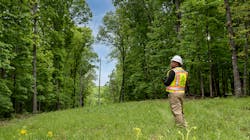It’s not unusual for those in the green and utility industries to spend a large amount of time in the field alone or sparsely populated areas — oftentimes plagued by mediocre to nonexistent cell service.
EHS Today describes lone workers as “people who perform their jobs alone, without someone else present and without any supervision. Lone workers are also people who are in the same building or area but are out of hearing distance.”
As ACRT’s Area Safety Representative chairwoman and Manager of its Ready Force team, I often preach the importance of preparedness to our lone and remote workers. Our Ready Force personnel can be anywhere in the country in a short amount of time to assist utilities with storm response and restoration efforts, but with this comes the unknown.
Even when this group of extremely experienced individuals sets out across the U.S. to lend an extra set of hands, it’s possible they’re traveling to places they may have never been before. While traveling can be appealing, there are two things to make note of.
1. The travel required to get to a project or location. When you’re on the road, not only do you have to drive safe, but you also must pick a good spot to spend the night.
2. Each job presents a new situation. Workers are often headed to places where they aren’t familiar with the topography. If a person goes towards the West coast, the weather systems are going to be way different than in the East. Even if they’re relatively close to another worker, it can be something they’re not used to. Lone workers must be prepared for everything.
Preparation is key. It’s important to prepare before a situation happens by putting yourself in the best position to react in the way needed. Give yourself the best odds to avoid injury and incident by researching the area, where you’re going to stay, the weather you’ll encounter, the length of time you plan to stay, and so on. Become an expert in that area.
For those who classify as a lone worker, ACRT recommends the following steps when working in remote areas.
- Ensure your cell is fully charged when leaving your vehicle.
- Carry a whistle for emergency use.
- Fill up in remote areas when you have a half tank of gas in case you need to overnight in your vehicle.
- Don’t travel at night. Plan your day so you can get in and out without dealing with low light levels.
- Check weather forecasts before you leave and while en route. Change your plans if necessary.
- Ensure your vehicle is well maintained and suitable for the terrain and area you’ll be traveling through.
- Ensure you have a reliable spare key to your vehicle.
- Keep emergency water, dry clothing, a flashlight with extra batteries, and non-perishable food items in your truck.
- The four vital requirements to support life are water, shelter, warmth, and food. Always ensure you set out with adequate supplies if you’re stranded. This is important even if you are planning to go to a remote area for only a short period.
According to EHS Today, “Lone workers face a range of safety hazards as long as the range of industries that employ people who work alone. The most common — and this isn’t only for lone work — are slips, trips, and falls.”
Ultimately, regardless of the industry we belong to, we must take ownership of our safety.
When possible, use the “buddy system” and always have someone to check in and out with when working alone, especially in areas with poor cell service. Make sure someone knows where you are working.
By staying prepared, taking personal accountability, and keeping an open line of communication with one another, we can continue to work toward a safer industry.
Anna Davis is an operations manager at ACRT. She is an ISA Certified Arborist and oversees the ACRT Ready Force® team. Davis serves as chairwoman of the Area Safety Representative group for ACRT and is a member of the ACRT Services family of companies’ Wellness Committee. She holds a bachelor's degree in Geography with GIS from the University of Alabama in Tuscaloosa, Ala.
